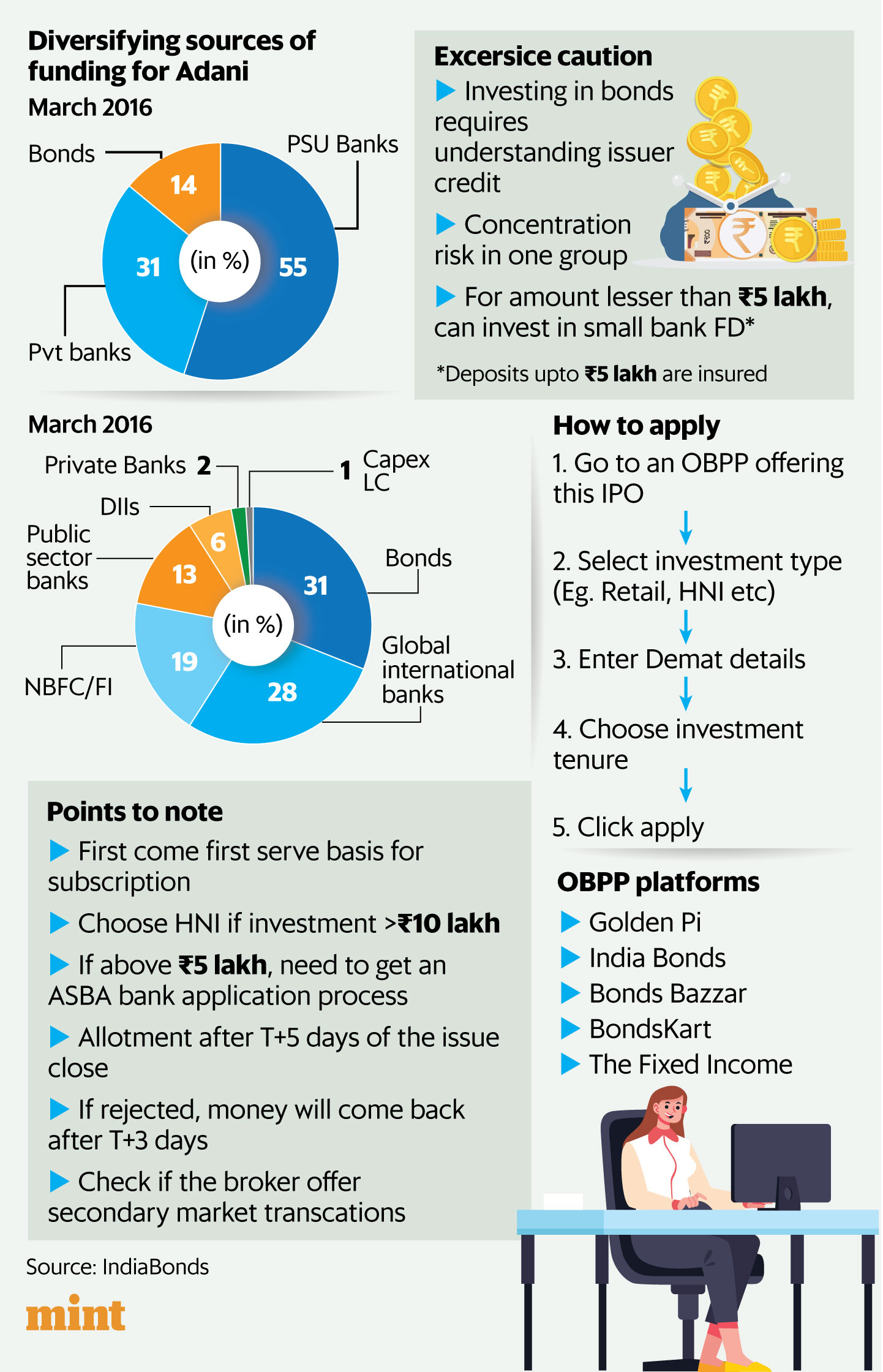In a market dominated by non-bank financiers, a public bond issued by an Adani group entity is the first from a non-lending company since 2016, when the National Highways Authority of India came out with an issue. A public bond market issue is when a company offers it to retail, or individual, investors.
The Adani group has been working to diversify its borrowings the past 8 years, and the public bond issue is a step in that direction. Jugishinder Singh, chief financial officer of Adani group, said this issue will test the domestic debt capital market for corporate bond issues.
The Adani group is involved in capital-intensive sectors and relies heavily on long-term borrowing options. It will use about 75% of the proceeds from the bond issue for prepayment or repayment of debt and keep aside the remaining amount for other corporate purposes.
This bond issue could also serve as a pilot to test whether the ports-to-media conglomerate can rely on Indian investors for its long-term borrowing needs, considering the allegations of financial impropriety made by US-based short seller Hindenburg Research in early 2023.
Also read |Are sovereign gold bonds the new ‘gold standard’ in investing?
“The maximum horizon (5 years) coincides with the next election cycle and does not cross over meaningfully, thereby infra-related policy risks are also somewhat mitigated,” said Sandipan Roy, chief investment officer of Motilal Oswal Private Wealth.
“There is a dearth of debt issuances from non-financial services sector companies and thus AEL can garner quite a bit of interest for the size of the issuance as well,” he added.
In the overall scheme of things, the ₹800 crore public issue will form a tiny share (1.4%) of the Adani group flagship firm’s overall gross borrowing of ₹57,000 crore.
“From an investment perspective, we don’t have a requirement for this,” Singh told Mint in an interview on the sidelines of a roadshow. “But from the funding structure point of view, we want to have a certain capital funding profile over the next 10 years.”

View Full Image
The offering
Adani Enterprise aims to raise ₹800 crore through secured, redeemable, non-convertible debenture. In simple words, the interest and the principal amount are backed by assets to the tune of 1.1 times, and do not offer an option to convert into equity shares. But the bond provides the option to redeem at chosen intervals.
The coupon rate ranges from 9.23% with a 24-month tenure, to 9.65% for a 36-month tenure and 9.90% for a 60-month tenure. Buyers can opt for quarterly, annual, or cumulative interest payments.
The issue is rated A+/positive by Care Ratings, two notches below the highest rating.
“Investors have choices in terms of whether they want regular cash flow or they want compounding with higher multiple on capital at maturity,” said Roy, the investment strategist of a domestic wealth manager that has over ₹1 trillion in assets under advisory.
“Investors who want regular cashflows should choose quarterly or annual cashflow options whereas investors looking at maximizing multiple on investment should look at compounding option,” said Roy.
Also read |Here’s how you can read different mutual fund ratios when picking a fund
The bond issue will open for subscription from 4-17 September. The bond will trade on BSE and NSE after the subscription.
The minimum ticket size for the IPO application is ₹10,000.
All listed securities including bonds held for more than 12 months will be treated as long-term assets and any gain from their sale will be taxable at 12.5%. Indexation, or adjusting for inflation, will not be applicable.
If such bonds are held for 12 months or less, they will be treated as short-term, and gains from their sale will be taxable at the applicable slab rates.
A 10% tax deducted source (TDS) is applicable on the coupon (interest) received. But investors need to pay the slab rate while filing their income tax returns.

View Full Image
How to invest
The public bond market is a niche market and not many people know how to apply for an issue. In reality, the process is relatively straightforward using the services of an online bond platform provider, OBPP.
Not all such providers offer IPO subscriptions and the step-by-step process will slightly vary from platform to platform. You can go to an OBPP platform and apply for a subscription. You will have to choose the tenure and how much you want to invest. The minimum amount for an IPO issue is ₹10,000.
Unlike a stock’s IPO, a public bond issue IPO is given on a first-come-first-served basis and will be stored in demat form. “If an investor is not allotted the issue for some reason, they will typically get the amount back after 5 days of the close of the issue,” said Vishal Goenka, co-founder of IndiaBonds.
Also read | What to keep in mind when investing with a new fund house
For investments up to ₹5 lakh, an application can be made through a UPI mandate. For greater amounts, investors will need to submit an ASBA form (applications supported by blocked amount) with their bank.
Non-resident Indians can invest in the Adani group public bond issue only if they have an NRO (non-resident ordinary) bank account, said Bondbazzar.
The risk factors
Investors should keep in mind that such bonds have exposure to one corporate group, which creates a concentration risk. Also, unlike with a bank fixed deposit, a public bond issue does not include a ₹5 lakh deposit insurance by the Reserve Bank of India.
Investors should consult their financial advisors and understand the risk before investing in such corporate bonds. Investors might also face difficulty while selling the bond in the secondary market.
“It is important to note that Investors should look at subscribing to these bonds with hold-to-maturity objective as there may not be much liquidity in the secondary market for these bonds,” said Roy of Motilal Oswal Private Wealth.